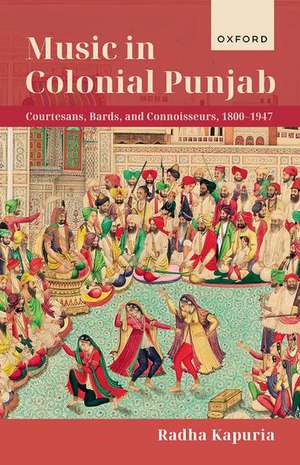Music in Colonial Punjab: Courtesans, Bards, and Connoisseurs, 1800-1947
Autor Radha Kapuriaen Limba Engleză Hardback – 15 mai 2023
Preț: 600.64 lei
Preț vechi: 859.88 lei
-30% Nou
Puncte Express: 901
Preț estimativ în valută:
114.93€ • 125.24$ • 96.85£
114.93€ • 125.24$ • 96.85£
Carte tipărită la comandă
Livrare economică 12-18 aprilie
Preluare comenzi: 021 569.72.76
Specificații
ISBN-13: 9780192867346
ISBN-10: 0192867342
Pagini: 410
Dimensiuni: 145 x 224 x 28 mm
Greutate: 0.64 kg
Editura: OUP OXFORD
Colecția OUP Oxford
Locul publicării:Oxford, United Kingdom
ISBN-10: 0192867342
Pagini: 410
Dimensiuni: 145 x 224 x 28 mm
Greutate: 0.64 kg
Editura: OUP OXFORD
Colecția OUP Oxford
Locul publicării:Oxford, United Kingdom
Recenzii
Music in Colonial Punjab is an important contribution to the cultural history of the Punjab. Kapuria has recovered an untold social history of music in the region that adds complexity to our understanding of colonial Punjab's history.
In a remarkable effort steeped in the archive, Radha Kapuria busts the popular image of Punjab as a land of only folk and devotional music. She turns her attention to the classical, urbane, rāgadārī music, whether nurtured in the court of Ranjit Singh or in cis-Satluj states of Patiala and Kapurthala. Her social history of music focuses attention on the myriad performers and expositors of the classical, and other genres; various women performers and their changing class and cultural backgrounds; to the mirāsīs, and their protean and evolving lives in pre-colonial and colonial times. Kapuria must be commended for a path-breaking work that will open new vistas for studying the social, cultural, and musical histories of Punjab.
This rigorously researched book heralds the long overdue 'depeasantification' and 'defolklorization' of the Punjab region through three centuries of music making in precolonial, colonial, and postcolonial Punjab. Replete with enlightening legends and anecdotes about kings and princes, courtesan queens and kanjaris, mirasis and missionary women and the progenitors of Punjab's gharanas, the book poignantly throws light on the denigration and marginalization of the hereditary custodians of Punjab's rich musical heritage with the birth of middle class performers and publics. The book promises to be an eyeopener in its unveiling of the region's varied musical heritage inferioritized as folk music.
This excellent study provides us with the first joined-up understanding of the complex roles that music and musicians (female and male alike) played in the socio-cultural and political history of the Punjab, as it moved to, through and away from colonial rule.
Radha Kapuria's impressive scholarly work complicates our understanding of Punjabi cultural production, outside of the usual domains - the rural, the martial and the folk - that, while important, have too often obscured our understanding of Punjab's urbane cultural forms. This fuller picture restores something important to the history of the region--and reinserts Punjab in a broader historical of South Asian classical music--and brings crucial focus on the women and hereditary musicians/bards (mirāsīs) who warrant a central place in Punjabi history.
For those intrigued at the complexity of Punjab's colonial history, this fascinating read provides an entry point through music.
In a remarkable effort steeped in the archive, Radha Kapuria busts the popular image of Punjab as a land of only folk and devotional music. She turns her attention to the classical, urbane, rāgadārī music, whether nurtured in the court of Ranjit Singh or in cis-Satluj states of Patiala and Kapurthala. Her social history of music focuses attention on the myriad performers and expositors of the classical, and other genres; various women performers and their changing class and cultural backgrounds; to the mirāsīs, and their protean and evolving lives in pre-colonial and colonial times. Kapuria must be commended for a path-breaking work that will open new vistas for studying the social, cultural, and musical histories of Punjab.
This rigorously researched book heralds the long overdue 'depeasantification' and 'defolklorization' of the Punjab region through three centuries of music making in precolonial, colonial, and postcolonial Punjab. Replete with enlightening legends and anecdotes about kings and princes, courtesan queens and kanjaris, mirasis and missionary women and the progenitors of Punjab's gharanas, the book poignantly throws light on the denigration and marginalization of the hereditary custodians of Punjab's rich musical heritage with the birth of middle class performers and publics. The book promises to be an eyeopener in its unveiling of the region's varied musical heritage inferioritized as folk music.
This excellent study provides us with the first joined-up understanding of the complex roles that music and musicians (female and male alike) played in the socio-cultural and political history of the Punjab, as it moved to, through and away from colonial rule.
Radha Kapuria's impressive scholarly work complicates our understanding of Punjabi cultural production, outside of the usual domains - the rural, the martial and the folk - that, while important, have too often obscured our understanding of Punjab's urbane cultural forms. This fuller picture restores something important to the history of the region--and reinserts Punjab in a broader historical of South Asian classical music--and brings crucial focus on the women and hereditary musicians/bards (mirāsīs) who warrant a central place in Punjabi history.
For those intrigued at the complexity of Punjab's colonial history, this fascinating read provides an entry point through music.
Notă biografică
Radha Kapuria is Assistant Professor in South Asian History at Durham University. This book draws on her PhD work at King's College London, which was nominated for the 2019 Bayly Prize. Her work straddles history, cultural studies, ethnomusicology, and gender studies. As well as interest in the Partition, she is currently also a co-editor and collaborator on projects exploring the intersections of regional, sonic, and environmental histories of South Asia.
